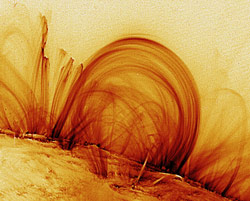Triggering Solar Mayhem

Solar flares are huge bursts of energy from the sun that occasionally disturb satellites and communications networks on earth. They’re caused by massive and sudden changes in solar magnetic fields, but researchers don’t know exactly how the fields can rearrange quickly enough to trigger a flare. According to a theory in the 29 November PRL, a flare occurs when magnetic field lines are squeezed past a critical point beyond which a new physical process kicks in, one that can release huge amounts of energy in a short period of time. Supercomputer simulations confirm the effect, which may also operate in the earth’s magnetic field and in the fields of experimental fusion reactors.
A solar flare releases energy at a staggering rate: It’s like 10 million volcanoes exploding within a few minutes. Flares come from so-called magnetic reconnection events, where magnetic field lines meet and fuse. Imagine a carpet on the sun’s surface with 100,000-kilometer-long “yarn loops” of magnetic field. If a loop becomes twisted by one half turn, the “yarn” on one side can fuse with the yarn on the other side at the single point where they touch, and the loop can break into two smaller loops that separate. Similar reconnections can occur any time two field lines touch or cross in this slowly churning carpet. A single event can take months, but occasionally, in a process that researchers don’t fully understand, reconnection accelerates dramatically and creates a flare.
The “spark” that ignites a flare occurs when field lines at the reconnection point are squeezed together beyond a critical density, say James Drake of the University of Maryland and his colleagues in their new theory. Each loop in the solar carpet is actually many concentric field lines that reconnect in sequence, starting with the innermost line. In the team’s scenario, magnetic “pressure” builds up at the reconnection point as many parallel lines squeeze in, awaiting their turn to reconnect, but unable to do so quickly. Reconnection is normally slow because each line must drag around the weight of particles stuck to it like beads on a string. Electrons zip around in tight orbits, while the much heavier positive ions circulate at a longer distance. If the magnetic pressure becomes so high that the ion orbits get disturbed, the lines suddenly shed their load of ions and can burst into reconnection tens of thousands of times faster, in a mode called Hall reconnection. The pent-up magnetic energy explodes with a blast of particles.
Drake and his colleagues confirmed their theoretical predictions with supercomputer simulations. Researchers haven’t been able to detect Hall reconnection in the sun because the key effects occur in such small regions, but satellites have spotted it in the earth’s magnetosphere.
“The authors have made a bold prediction, based on solid calculations,” says Spiro Antiochos of the Naval Research Laboratory in Washington, D.C. Eric Priest of the University of St. Andrews in Scotland says the paper “is likely to have wide implications for the onset of reconnection in solar flares, geomagnetic substorms, and other examples of dynamic plasma behavior in the universe.”
–Jane Andrew
Jane Andrew is a freelance science writer in Chicago.


